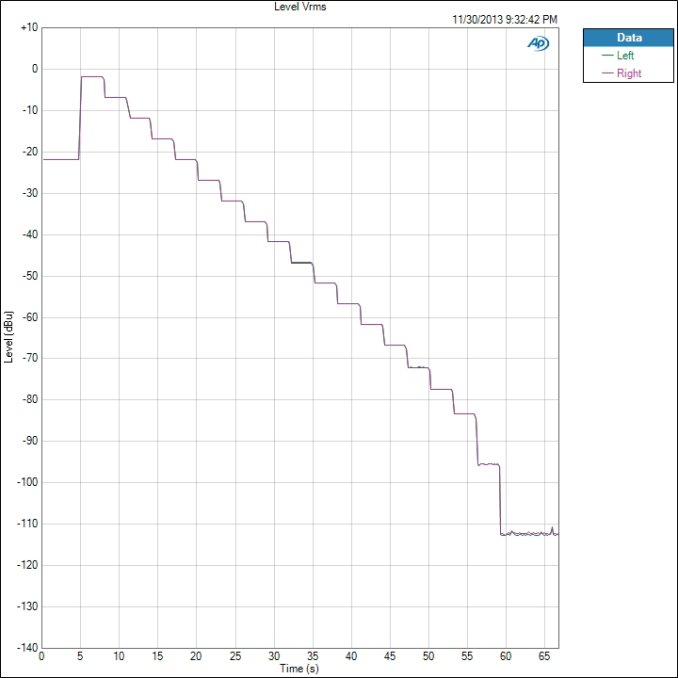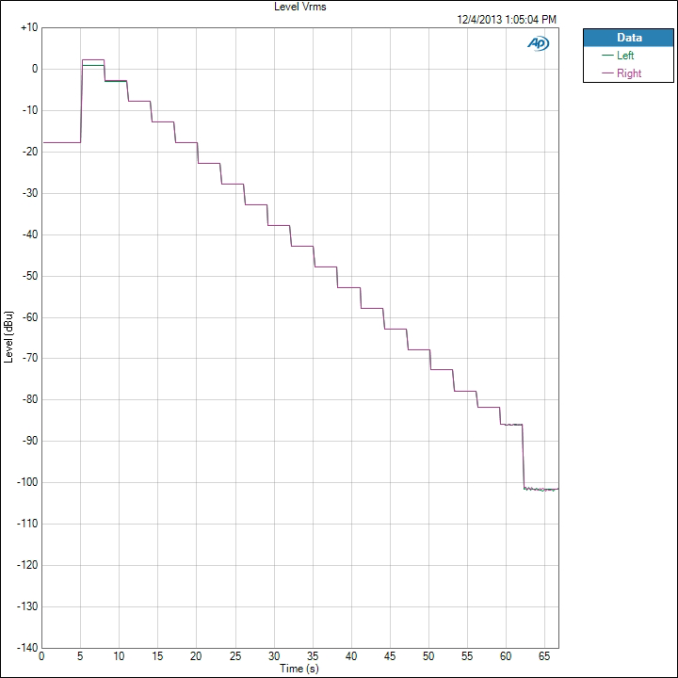Smartphone Audio Quality Testing
by Chris Heinonen on December 8, 2013 5:15 PM EST- Posted in
- Smartphones
- Audio
- Mobile
- Tablets
- Testing
Dynamic Range
The dynamic range of the phone indicates the difference between the loudest possible sound and the background noise. The more residual noise in the background, the lower the dynamic range. Phones with more powerful amplifier sections will typically produce a greater dynamic range. The residual noise level is often constant, so as the overall volume level increases the difference between the music and the noise increases as well.
The best performer here is the iPhone 5 again, with 92.214 dB of range. The worst is the Nexus 5 with only 89.332 dB. A difference of 3 dB is not something I would concern myself over. If we see a phone or tablet that drops down below 80 dB then I will start to show more concern.
Crosstalk
Crosstalk, like dynamic range, is just a number here. This is the measurement how much signal leaks from one channel into another. If an instrument should only be in the right ear, some of that signal will leak into the left ear, but we want that as low as possible. The results are expressed in -dB, or how much quieter one ear is than the intended ear.
On the Note 3 we see a wonderful crosstalk measurement of -117.2 dB so the sounds in one ear are -117 dB quieter in the other ear. This makes them impossible to hear. The worst is the iPhone 5, with only -75.624 dB of isolation.
Stepped Response
The stepped response uses a 1 kHz 0 dBFS tone but measures output level from maximum volume to minimum volume. We can see how large the volume steps are and how many there are. It doesn’t produce a number we can use, but it ties back into our other results. For a good example, we can look at the Note 3.
We see steps that are around -5 dBu each. The final level is muted and just the background noise of the device. Each step is clean and even but as we get lower and lower we see noise start to intrude. This is the background noise starting to become audible in the signal. The flatter the levels are, the quieter it will be. Now, let us look at the Nexus 5.
Notice at the very top how the right and left channels do not overlap. That is the clipping we talked about at the very beginning. It isn’t until the 4th volume setting that the level difference is down to nothing. Because of this, I would consider the top 3 volume settings of the Nexus 5 as ones that should be avoided. They each have enough THD+N introduced into them that it will sound poor, and one ear will be louder than the other.












188 Comments
View All Comments
dylan522p - Sunday, December 8, 2013 - link
The One is very interesting in terms of quality. There is a huge difference between the stock music, google play music, power amp, and astro. Astro is the best quality.Impulses - Monday, December 9, 2013 - link
You know, you briefly alluded to the single biggest difference maker and a ton of people would still take it for granted... If you're using crappy headphones much of this is wholly irrelevant. At the same time, expensive headphones aren't always an upgrade... For one thing you've got the Beats and Bose of the world getting by on marketing, and even beyond that not every headphone will be a good match to any given phone depending on how hard to drive it is (or isn't) and how out of whack the phone's output impedance is (something that's often taken for granted even with dedicated audio components).Daniel Egger - Sunday, December 8, 2013 - link
I always thought the reference for audio testing equipment, especially in telecommunications, was HEAD acoustics. Still a good and interesting article.Drumsticks - Sunday, December 8, 2013 - link
Jeez Anandtech rocks. Thanks guys!RoninX - Sunday, December 8, 2013 - link
Great! This is exactly what I've been waiting for.I've noticed the audio quality on my Droid 4 is sufficiently poor that I continue to carry around an iPod Classic along with the D4. I'm hoping that the sound quality on my next phone, likely either a Note 3 or the next gen HTC One (One Two?), will be good enough that this isn't necessary.
pukemon1976 - Sunday, December 8, 2013 - link
2 thumbs up for galaxy note 3 audio quality. was quite surprised.dylan522p - Sunday, December 8, 2013 - link
One definely. The internal amp adds tons to quality the Two or whatever it is called will assuradly be even better.quick brown fox - Sunday, December 8, 2013 - link
As a mild audiophile who occasionally searches for electrical measurements of DAPs/smartphones on IF/GE/GSMA/Voldemort's Blog/etc, I am very pleased seeing this article in Anandtech! Had a mild laugh seeing the HTC One 'Beats Enabled' frequency response (is the treble peak still there without Beats?), and I'm very much looking forward to seeing some Nvidia Shield/SIII i9300 measurements.cheinonen - Sunday, December 8, 2013 - link
With Beats disabled, you actually see a bit of a roll-off in the bass and the treble. It's +/- 0.230 dB so not a level you'll likely hear. Overall the response is very flat if you turn off Beats. I'm still testing something else I found with the HTC One before I have full numbers up there.quick brown fox - Sunday, December 8, 2013 - link
Thanks. Again, this article is excellent; looking forward for more measurements!